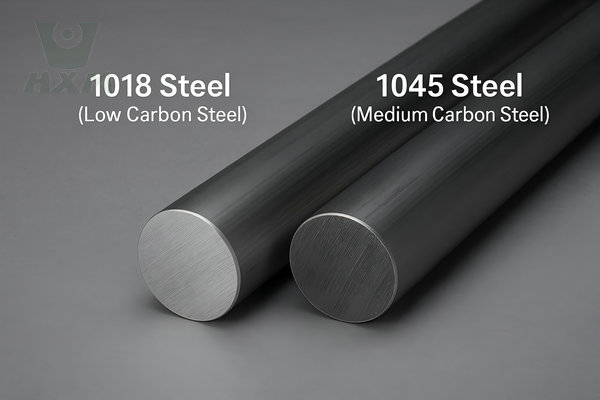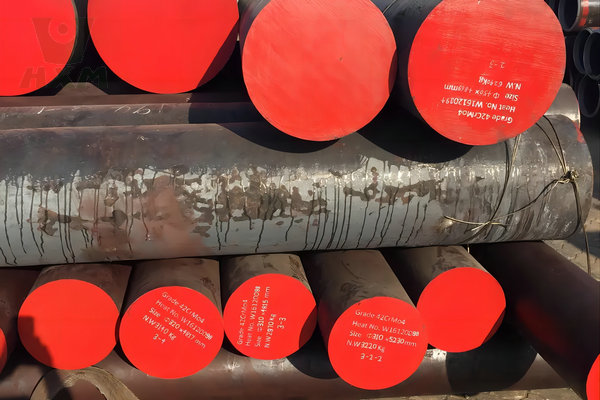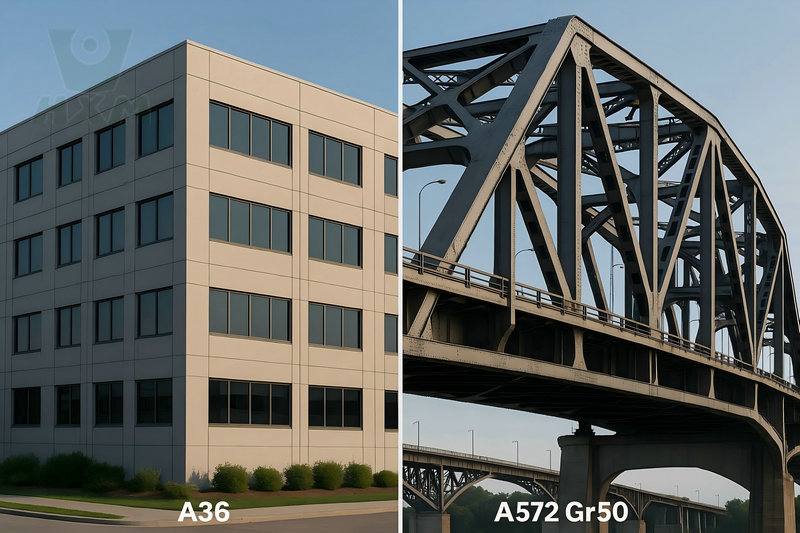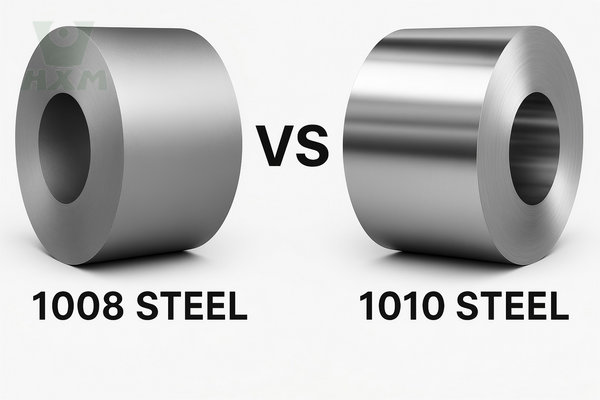In this comparison, we will explore the definitions of both grades, analyze their differences in composition and properties, and ultimately determine which material is better suited for specific applications.
This guide will provide you with a comprehensive and in-depth comparative analysis based on the actual needs of engineers and purchasers to help you make the most informed decision between 1018 and 1045 steel.
What Is 1018 Steel?
1018 steel is a low-carbon steel that contains approximately 0.18% carbon content. It is one of the most commonly used grades of carbon steel due to its relatively low cost, ease of machining, and good mechanical properties. The low carbon content in 1018 steel provides excellent weldability and formability, making it suitable for various applications where moderate strength and toughness are required.
What Is 1045 Steel?
1045 steel, on the other hand, is a medium-carbon steel with around 0.45% carbon content. This higher carbon content results in increased strength and hardness compared to 1018 steel. 1045 steel is commonly used in applications that require higher strength and wear resistance, such as axles, gears, shafts, and other machinery parts.
1018 Vs 1045 Steel Differences

The strength and thickness of the steel plate are crucial factors in ensuring structural integrity and safety. Higher-strength steel plates offer better load-carrying capacity, making them suitable for heavy-duty applications. However, it’s essential to strike a balance between strength and weight, as thicker plates can increase the overall weight of the structure. Perform a thorough structural analysis and consult with engineers to determine the optimal thickness and strength requirements for your project.
| Property | 1018 Steel (Low Carbon) | 1045 Steel (Medium Carbon) | What It Means for You |
|---|---|---|---|
| Carbon Content | ~0.18% | ~0.45% | Carbon content is the key factor determining steel properties. |
| Hardness (Brinell) | ~126 HB | ~170 HB (Annealed) | 1045 is harder and more wear-resistant. |
| Tensile Strength | ~440 MPa | ~625 MPa (Annealed) | 1045 can handle higher tensile loads. |
| Machinability | Excellent | Good | 1018 is easier to machine and tool-friendly. |
| Weldability | Excellent | Poor | 1018 is easier to weld; 1045 requires professional welding. |
| Heat Treatment Response | Suitable only for surface hardening | Responds well to quenching and tempering | 1045 can be significantly strengthened through heat treatment. |
| Cost Index | Lower | Slightly Higher | 1018 is typically a more economical option. |
| Core Advantage | Excellent formability and weldability | High strength and hardness | Choose based on your primary performance needs. |
1018 Vs 1045 Steel Carbon Content:
- 1018 Steel: It is a low-carbon steel with approximately 0.18% carbon content. The low carbon presence contributes to its favorable weldability and formability characteristics.
- 1045 Steel: This is a medium-carbon steel containing around 0.45% carbon. The higher carbon content imparts increased strength and hardness, making it suitable for applications requiring higher mechanical properties.
1018 Vs 1045 Steel Strength and Hardness:
- 1018 Steel: Due to its lower carbon content, 1018 steel offers lower tensile strength and hardness compared to 1045 steel. It is considered a mild steel, making it easier to work with but with lower overall mechanical performance.
- 1045 Steel: With its higher carbon content, 1045 steel exhibits higher tensile strength and hardness. This increased strength makes it an excellent choice for applications where more robust and durable materials are necessary.
1018 Vs 1045 Steel Machinability:
- 1018 Steel: Known for its exceptional machinability, 1018 steel is easy to cut, drill, and machine due to its lower carbon composition. This makes it a preferred option for projects requiring extensive machining operations.
- 1045 Steel: While still machinable, 1045 steel is not as easy to work with as 1018 steel due to its higher carbon content. Care must be taken during machining to maintain tool integrity and avoid excessive wear.
1018 Vs 1045 Steel Weldability:
Both 1018 and 1045 steel possess good weldability. However, the lower carbon content in 1018 steel generally results in easier welding compared to 1045 steel.
1018 Vs 1045 Steel Cost:
When it comes to cost, 1018 steel is generally less expensive than 1045 steel. The primary reason for this price difference is the variation in the carbon content between the two materials.
1018 steel, being a low-carbon steel with approximately 0.18% carbon content, is easier and less expensive to produce. The lower carbon content requires less refining during the manufacturing process, which contributes to its lower cost.
On the other hand, 1045 steel, being a medium-carbon steel with around 0.45% carbon content, requires more careful processing and additional alloying elements to achieve its desired properties, such as increased strength and hardness. These additional steps in the manufacturing process for 1045 steel make it relatively more expensive compared to 1018 steel.
As with any material, the exact cost difference between 1018 and 1045 steel may vary depending on factors such as the current market conditions, supplier, location, and the quantity of material being purchased. However, in general, you can expect 1018 steel to be more cost-effective compared to 1045 steel.
1018 Vs 1045 Steel Heat Treatment:
1018 Steel: It cannot be hardened through the entire surface. It is only suitable for surface hardening treatments such as carburizing. This forms a thin, hard and wear-resistant layer on the surface of the part, while the core remains soft and ductile.
1045 Steel: It responds very well to heat treatment. Through quenching and tempering, its hardness and strength can be precisely controlled to adapt it to a variety of demanding applications. This is the core of the value of 1045 steel.
Conclusion: If your part needs high hardness and high strength through the entire surface, 1045 steel is the only choice.
1018 Vs 1045 Applications:
- 1018 Steel: Commonly used in applications where moderate strength, good weldability, and formability are essential. Examples include bolts, studs, couplings, and general machinery parts.
- 1045 Steel: Suitable for applications requiring higher strength, hardness, and wear resistance. It is often used in gears, axles, shafts, and other components subjected to higher stress and mechanical loads.
How to choose between 1018 and 1045 steel: a simple decision guide
Still not sure what to choose? Answer the following questions to help you make a decision:
Does your part require extensive welding?
- Yes → Choose 1018 Steel
Does your part require complex bending or cold forming?
- Yes → Choose 1018 Steel
Is cost the primary consideration, and strength is not a high requirement?
- Yes → Choose 1018 Steel
Does your part need to withstand high stress or wear?
- Yes → Choose 1045 Steel
Do you plan to significantly increase the hardness and strength of the part through heat treatment?
- Yes → Choose 1045 Steel
Is the strength and durability of the part more important than ease of machining or welding?
- Yes → Choose 1045 Steel
Frequently Asked Questions: 1018 Vs 1045 Steel
Which steel is more corrosion resistant?
Both are carbon steels, which have poor rust resistance and are prone to rust in humid environments. They both need to be protected from corrosion by coating, electroplating or other surface treatments.
Can I use 1045 steel instead of 1018 steel?
Direct substitution is not recommended. While 1045 steel is stronger, it is much less weldable and formable. If your design is based on the properties of 1018, a hasty substitution could result in production issues or part failure.
How much more expensive is 1045 steel than 1018 steel?
Typically, the raw material cost of 1045 steel is slightly higher than that of 1018 steel. However, the final cost difference also depends on the required processing and heat treatment processes.
In conclusion
In conclusion, the choice between 1018 and 1045 steel depends on the specific requirements of the project. If cost-effectiveness, formability, and ease of machining are important, 1018 steel may be the preferred option. On the other hand, if increased strength, hardness, and wear resistance are crucial, 1045 steel would be a more appropriate choice.









